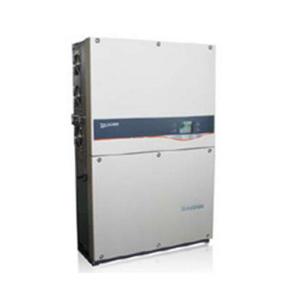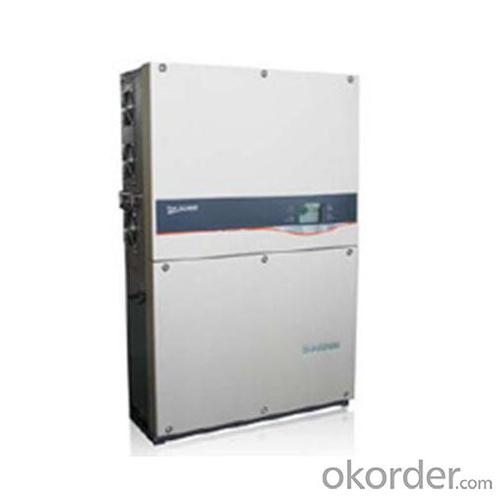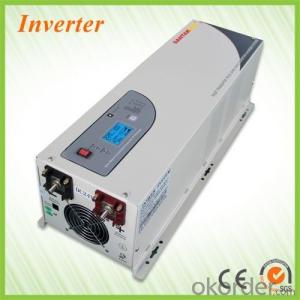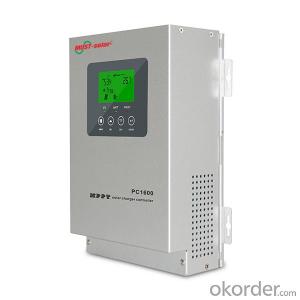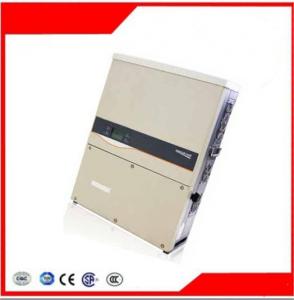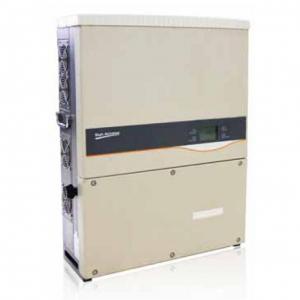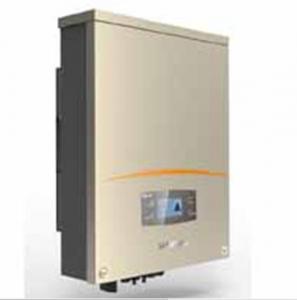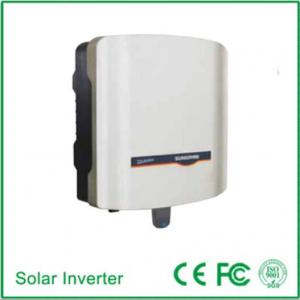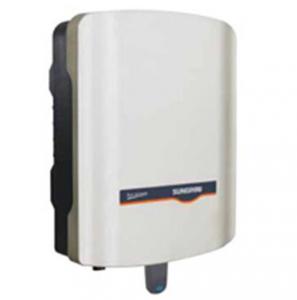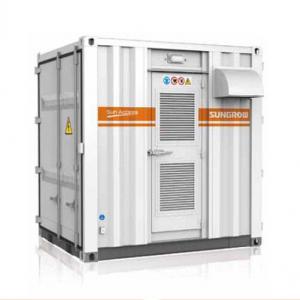Solar Photovoltaic Grid-Connected Inverter SG60KTL
- Loading Port:
- China Main Port
- Payment Terms:
- TT or LC
- Min Order Qty:
- 50000 unit
- Supply Capability:
- 3000000 unit/month
OKorder Service Pledge
OKorder Financial Service
You Might Also Like
1. Structure of Solar Photovoltaic Grid-Connected Inverter SG60KTL Description
Suitable for 50Hz/60Hz grid, could be used in Asia, Africa and Europe. Available for hand installation, no need for lifting machinery assistance.
IP65;Integrated DC combine and surge protection function
TUV,CE,G59/3,BDEW,CGC,GB-T19964
2. Main Features of the Solar Photovoltaic Grid-Connected Inverter SG60KTL
Flexible
• Handy and light, easy to handle without lift machinery assistance, lower the cost of installation and maintenance.
• Integrated DC combine and surge protection function, lower the system cost
• DC arc detection function(optional), further enhance the safety performance
Efficient
• Max. Efficiency at 99%
• Integrated string detection function, find mismatch panel in time and accurately
• Integrated PV panel PID effect eliminate function( optional), decrease the loss of generation attenuation.
Grid-friendly
• Fullfil a variety of reactive power adjustment requirments with power factor 0.8overexited ~0.8 underexited
• Active power continuously adjustable (0~100%)
• Integrated LVRT , HVRT and night SVG function
Qualified
• TÜV, CE, G59/3, BDEW, CGC and GB-T19964 certification.
3. Solar Photovoltaic Grid-Connected Inverter SG60KTL Images
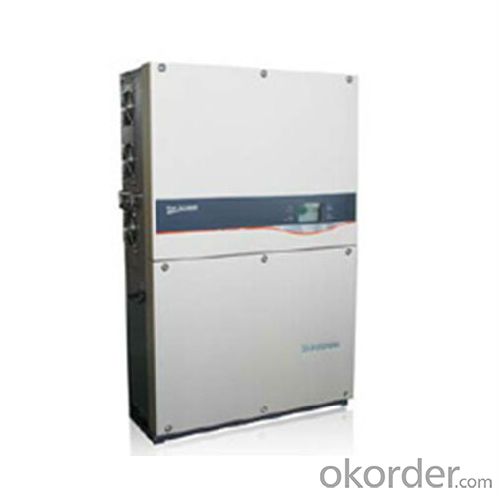
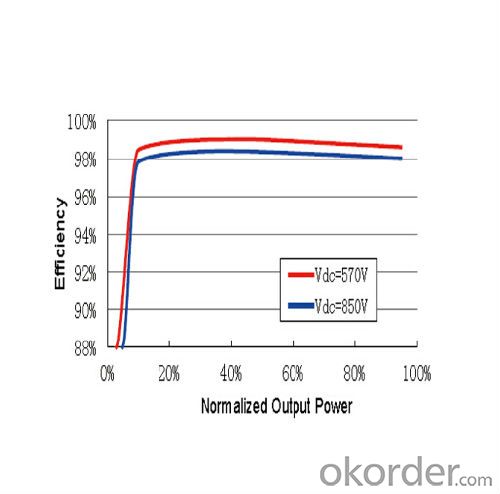

4. Solar Photovoltaic Grid-Connected Inverter SG60KTL Specification
Grid Type | 230V/400Vac |
Input Side Data | |
Max. PV input power | 67500W |
Max. PV input voltage | 1000V |
Startup voltage | 620V |
MPP voltage range | 570~950V |
MPP voltage range for nominal power | 570~850V |
No. of MPPTs | 1 |
Max. number of PV strings per MPPT | 12 |
Max. PV input current | 120 |
Max. current for input connector | 12A |
Output Side Data | |
Nominal AC output power | 60000W |
Max AC output power(PF=1) | 66000W |
Max. AC output apparent power | 66000VA |
Max. AC output current | 96A |
Nominal AC voltage | 3P+N+PE/3P+PE, 230/400Vac |
AC voltage range | 310~480Vac |
Nominal grid frequency | 50Hz/60Hz |
Grid frequency range | 45~55Hz/55~ 65Hz |
THD | < 3 % (Nominal power) |
DC current injection | <0.5 %In |
Power factor | >0.99@default value at nominal power,(adj. 0.8overexcited ~0.8underexited) |
Protection | |
Anti-islanding protection | Yes |
LVRT | Yes |
DC reverse connection protection | Yes |
AC short circuit protection | Yes |
Leakage current protection | Yes |
DC switch | Yes |
AC switch | Optional |
DC fuse | Yes |
PV String detection | Optional |
ARC detection | Optional |
DC Overvoltage protection | DC Type II DIN rail surge |
AC Overvoltage protection | Optional AC Type II DIN |
System Data | |
Max. efficiency | 99.00% |
Max. European efficiency | 98.70% |
Isolation method | Transformerless |
Ingress protection rating | IP65 |
Night power consumption | <1W |
Operating ambient temperature range | -25~60℃(>50℃ derating) |
Allowable relative humidity range | 0~100% |
Cooling method | Smart forced air cooling |
Max. operating altitude | 4000m (>3000m derating) |
Display | Graphic LCD |
Communication | RS485 |
DC connection type | MC4/Screw Clamp terminal |
AC connection type | Screw Clamp terminal |
Certification | VDE0126-1-1,EN62109-1,EN62109-2,G59/3, |
Mechanical Data | |
Dimensions(W×H×D) | 634×959×267mm |
Mounting method | Wall bracket |
Weight | 55kg |
*Specifications subject to change without notice.
5. FAQ of Solar Photovoltaic Grid-Connected Inverter SG60KTL
Q1. What is the difference between inverter and solar inverter?
A1. Inverter only has AC inpput, but solar inverter both connect to AC input and solar panel, it saves more power.
Q2. What is the difference between MPPT&PWM?
A2. MPPT has higher efficiency, it can track the max power point and won't waste energy.
- Q: Can a solar inverter be used with a solar-powered greenhouse system?
- Yes, a solar inverter can be used with a solar-powered greenhouse system. A solar inverter converts the direct current (DC) produced by solar panels into alternating current (AC) that can be used to power electrical devices. In a solar-powered greenhouse system, solar panels generate electricity from the sun's energy, which is then converted by the inverter to power the various components of the greenhouse, such as fans, lights, and irrigation systems.
- Q: Can a solar inverter be integrated with energy management systems?
- Yes, a solar inverter can be integrated with energy management systems. In fact, many modern solar inverters are designed to be compatible with energy management systems, allowing for better monitoring, control, and optimization of the energy generated by the solar panels. This integration enables users to track their energy production, consumption, and storage, and make informed decisions on energy usage to maximize efficiency and cost savings.
- Q: Can a solar inverter be used with a solar-powered backup generator?
- Yes, a solar inverter can be used with a solar-powered backup generator. A solar inverter is responsible for converting the DC (direct current) electricity generated by solar panels into AC (alternating current) electricity that can be used to power household appliances and other electrical devices. A solar-powered backup generator, on the other hand, uses solar energy to charge its batteries or store excess electricity. When the solar panels are generating electricity, the solar inverter will convert the DC electricity into AC electricity, which can be used directly in the household or sent back to the grid if the system is connected to it. If there is excess electricity being generated and the batteries of the solar-powered backup generator are fully charged, the solar inverter can divert the excess electricity to other loads or devices. During periods when solar energy is insufficient or not available, the solar-powered backup generator can kick in and provide the necessary electricity to power the house or recharge the batteries. In this case, the solar inverter will still be responsible for converting the DC electricity generated by the solar-powered backup generator into AC electricity. So, to summarize, a solar inverter can definitely be used with a solar-powered backup generator to ensure a continuous supply of electricity even when solar energy is limited.
- Q: How does a solar inverter handle low light conditions or cloudy days?
- A solar inverter handles low light conditions or cloudy days by adjusting its power output to match the available sunlight. It is designed to maximize the energy conversion efficiency even in low light situations, allowing for continuous power generation from the solar panels.
- Q: How do I monitor the performance of a solar inverter?
- To monitor the performance of a solar inverter, you can follow these steps: 1. Use a monitoring system: Many solar inverters come with built-in monitoring systems that provide real-time data on their performance. These systems often have user-friendly interfaces that allow you to easily track key metrics like energy production, voltage, and frequency. 2. Install a monitoring device: If your solar inverter doesn't have a built-in monitoring system, you can install an external monitoring device. These devices can be connected to the inverter and provide detailed performance data, which can be accessed through a dedicated software or app. 3. Track energy production: Keep a record of the energy produced by your solar inverter on a daily, weekly, or monthly basis. This will help you assess its performance over time and identify any potential issues or discrepancies. 4. Monitor key metrics: Monitor important metrics such as voltage and frequency to ensure that your solar inverter is operating within the desired parameters. Deviations from the expected values could indicate a problem that needs attention. 5. Set up alerts: Some monitoring systems or devices allow you to set up alerts for specific performance thresholds. This way, you will be notified if the inverter's performance falls below or exceeds certain limits, enabling you to take prompt action. 6. Regularly check for errors or alarms: Check the monitoring system or device for any error codes or alarms that indicate malfunctions or issues with the inverter. Addressing these problems early on can prevent further damage and optimize performance. By regularly monitoring the performance of your solar inverter, you can ensure its efficiency, detect potential problems, and maximize the energy output of your solar system.
- Q: What is the role of a DC-DC converter in a solar inverter?
- The role of a DC-DC converter in a solar inverter is to convert the direct current (DC) generated by the solar panels into the appropriate voltage and current levels required for the inverter to convert it into alternating current (AC) electricity. The DC-DC converter ensures efficient power transfer and enables the solar inverter to maximize the energy harvested from the solar panels. Additionally, it helps regulate the voltage levels and maintain the stability of the solar power system.
- Q: What is the role of a solar inverter in a grid-tied system?
- The role of a solar inverter in a grid-tied system is to convert the direct current (DC) electricity produced by the solar panels into alternating current (AC) electricity that can be used by the electrical grid or consumed by the appliances and devices in a home or business. It also ensures that the solar energy generated is synchronized with the grid's voltage and frequency to enable efficient and safe transfer of power. Additionally, the solar inverter monitors and controls the flow of electricity between the solar panels, the grid, and any energy storage systems that may be connected to the system.
- Q: Can a solar inverter be used with a solar-powered refrigerator?
- Yes, a solar inverter can be used with a solar-powered refrigerator. The solar inverter is responsible for converting the direct current (DC) electricity generated by the solar panels into alternating current (AC) electricity, which is required to power the refrigerator. By using a solar inverter, the solar-powered refrigerator can operate efficiently and effectively by utilizing the solar energy collected from the panels.
- Q: Can a solar inverter be remotely monitored and controlled?
- Yes, a solar inverter can be remotely monitored and controlled. With the advancement in technology, many solar inverters now come equipped with built-in communication capabilities such as Wi-Fi, Ethernet, or cellular connectivity. These features allow users to access and control the inverter's performance, settings, and data remotely through a computer, smartphone, or web-based monitoring platforms. This remote monitoring and control capability provides convenience, real-time updates, and greater control over the solar power system's performance and energy generation.
- Q: Can a solar inverter be used with different types of energy management systems?
- Yes, a solar inverter can be used with different types of energy management systems. Solar inverters are designed to convert the direct current (DC) generated by solar panels into alternating current (AC) that can be used to power various electrical devices. They are compatible with different energy management systems, including grid-tied systems, off-grid systems, and hybrid systems. The inverter's main function is to ensure the efficient and safe conversion of solar energy, regardless of the type of energy management system it is paired with.
Send your message to us
Solar Photovoltaic Grid-Connected Inverter SG60KTL
- Loading Port:
- China Main Port
- Payment Terms:
- TT or LC
- Min Order Qty:
- 50000 unit
- Supply Capability:
- 3000000 unit/month
OKorder Service Pledge
OKorder Financial Service
Similar products
Hot products
Hot Searches
Related keywords
